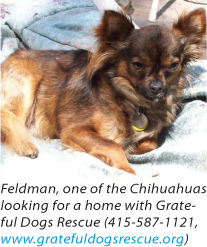 |

|
|||||||
|
When I was looking to adopt a pit bull in the summer of 2006, I turned to Petfinder.com, a wonderful Web site that allows you to enter specific criteria (breed, sex, age, proximity) and search for animals in shelters and with rescue groups all over the country. When I entered my zip code, over 5,000 pit bulls and pit bull mixes were available just in Northern California alone, far more than any other breed. One of them was a piebald, blue-eyed beauty named Blue – it was love at first sight, and the rest is 28 chapters and counting. I added Jasmine to her name for some much-needed femininity, but I kept Blue, too, because I wanted to honor where she came from. Where Jasmine Blue came from is the
 same place eight million dogs and cats come from each year – the American shelter system. Of this number, more than half are put to death for lack of homes. And it’s not just mongrels – more than a quarter of the animals in shelters are purebreds. Of all breeds, pit bulls fair the worst: In most shelters they account for more than half the dog population, and their euthanasia rate is nearly 95 percent. same place eight million dogs and cats come from each year – the American shelter system. Of this number, more than half are put to death for lack of homes. And it’s not just mongrels – more than a quarter of the animals in shelters are purebreds. Of all breeds, pit bulls fair the worst: In most shelters they account for more than half the dog population, and their euthanasia rate is nearly 95 percent.In 2006, one breed that did not top the euthanasia list was Chihuahuas. Thanks to America’s insatiable appetite for pop culture, the shivery little dogs were numero uno on the desirability scale because Paris Hilton put a pooch in her purse. Elle Woods, the fictional character from the film Legally Blonde carried one to law school. And just when you thought the market was saturated, along comes a movie called Beverly Hills Chihuahua. Suddenly Chihuahuas were as in demand as Jimmy Choos among the wannabe trendsetters. This wasn’t lost on greedy breeders, who began churning out Chihuahuas faster than you can say Tinkerbell. Unfortunately, wannabe trendsetters are really only trend followers, and shortly after the Chihuahua explosion, Paris lost interest in “Tinkerbell” and started carrying around a Pomeranian so small it made tiny Tink look like Godzilla. On top of that, people were discovering that Chihuahuas, while conveniently sized, aren’t for everyone.  “Are those 20-year-old girls still going to be carrying that Chihuahua in their purse 20 years from now?” asks Alison Lindquist, owner of a rescued Chihuahua and director of the East Bay SPCA. “They’ll have been through two marriages, have three kids, and that dog will still be peeing on the carpet.” It turns out that Chihuahuas, like many small breeds, live a long time, and they are notoriously difficult to housebreak. “Are those 20-year-old girls still going to be carrying that Chihuahua in their purse 20 years from now?” asks Alison Lindquist, owner of a rescued Chihuahua and director of the East Bay SPCA. “They’ll have been through two marriages, have three kids, and that dog will still be peeing on the carpet.” It turns out that Chihuahuas, like many small breeds, live a long time, and they are notoriously difficult to housebreak. At the end of 2009, Chihuahuas were catching up to pit bulls, making up one-third of the shelter dog population here in San Francisco alone. Unlike pit bulls, which are resilient and adaptive and do remarkably well in the shelter environment, Chihuahuas are like fish out of water, shaking in the back of their kennels, overwhelmed by the incessant barking and whining, the cold cement floors, and the stench of death and uncertainty. While they can be great dogs for the right person, Chihuahuas don’t always make good family pets. In fact, pit bulls, which love children and tend to be as adaptive outside the shelter as in, are a much better fit for most households. In a 2008 study from the Center for the Interaction of Animals and Society at the University of Pennsylvania, Chihuahuas ranked second of 33 breeds rated for aggression, just before Jack Russell terriers (Dachshunds were number one). “I have Harvard graduates for clients who can’t control a Chihuahua,” says “Dog Whisperer” Cesar Milan. Since most people who jumped on the Chihuahua bandwagon didn’t do their homework, many of these dogs wound up in the wrong homes, and now we have a Chihuahua crisis. Recently, Grateful Dogs Rescue executive director Kim Durney and the folks at San Francisco Animal Care and Control came up with the idea of holding a press conference to alert people to the problem. It was a huge success, going viral nationally in a matter of hours. The Jason Debus Heigl Foundation, an animal welfare organization founded by Grey’s Anatomy star Katherine Heigl in honor of her late brother, donated $25,000 and teamed with American Airlines to fly 25 Chihuahuas from an overburdened Hollywood shelter to Boston where, evidently, there is a Chihuahua shortage. I touched on the topic for our September cover story (“How the San Francisco SPCA let us down”) and, as I found out when I interviewed Kathleen Helmer of the Selma shelter in Fresno, this is nothing new. Last year, a woman flew over 50 small dogs on her private jet from Selma to Canada – where, evidently, there is also a small dog shortage – but just days later, 50 more took their place. The Central Valley puts down more than 50,000 animals per year, yet a vocal minority of breeders continues to stall mandatory spaying and neutering laws. While I blame ignorant, pop-culture-driven buyers for fueling the greedy lust of breeders, I also blame breeders for ignoring what is obviously a horrific situation. The purebred problem Holding breeders responsible
|
||||||||
 |
||||||||
|
||||||||
|
||||||||
|
||||||||

|
||||||||


